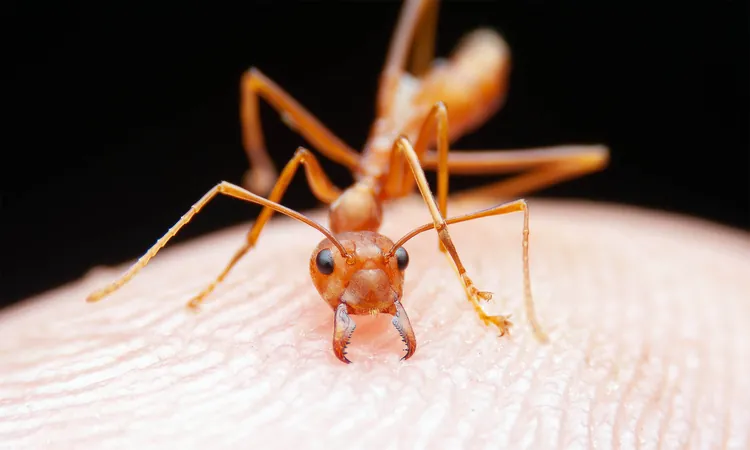
How an 8-Year-Old's Curious Moment Unlocked New Insights into Ants and Ecosystems
2025-01-09
Author: Jia
In a fascinating twist of fate, an ordinary afternoon turned extraordinary for eight-year-old Hugo when he stumbled upon a line of ants diligently hauling what he thought were seeds through his backyard. This innocent observation has set the stage for remarkable revelations in the study of ants and their interactions with other species, particularly regarding oak galls created by wasps.
Unlocking the Mystery of Oak Galls
Upon further inspection, Hugo's father, entomology professor Andrew Deans at Penn State University, identified these oak galls—growths formed when wasps lay their eggs in oak trees. They serve as protective shelters for developing wasp larvae, and their presence opens a new chapter in ecological understanding.
Working alongside other researchers, Deans embarked on an exploration to understand whether these galls could mimic the enticing traits of seeds, particularly their fatty substances that attract ants. The investigation revealed that many oak galls possess a fatty coating, known as a hood, which not only entices the ants but also serves a critical purpose for the wasp larvae inside.
A Clever Ploy
Ants are known to be attracted to fatty acids, often seen in the special structures of seeds. Once the ants transport the galls to their nests, they feast on the fatty parts while leaving the rest intact, thereby offering an unintentional safe haven for the larvae hidden within. This behavior has led researchers to propose that these galls may emit a chemical profile that mimics the scent of dead insects—another common food source for ants.
“It's remarkable how these structures reflect the chemical signature of dead insects, tricking ants into thinking they've found a meal,” stated John Tooker, a professor of entomology at the University of Pennsylvania. This clever deception illustrates the intricate web of interactions in nature, making it evident that evolution often leads to fascinating adaptations.
The Long Evolutionary Story
Galls have been associated with oak trees for millions of years, but the relationship between wasps, ants, and these mysterious formations is still being unearthed. While experts debate whether wasps influenced oak evolution to produce galls or whether it was the ants' attraction to fatty acids that prompted this adaptation, one thing is clear: the connection between these species exemplifies an ecosystem's complexity.
Hugo’s encounter has not only invokes curiosity but also emphasizes the importance of conserving natural habitats. Deans warns that oak trees and their wasp visitors face significant threats from habitat loss and climate change—factors that can destabilize these intricate relationships.
A Call for Conservation
Reflecting on this intriguing discovery, Andrew Deans remarked, “This highlights the vast knowledge we still lack about ecosystems and stresses the urgency of preserving biodiversity.” The interdependent relationships seen in the world of ants and wasps demonstrate how every species plays a critical role in maintaining ecological balance.
Conclusion: Curiosity Can Change the World
What started as a simple observation by a child has blossomed into a groundbreaking research project, stimulating inquiry into how various insects might interact in similar fashions. This event serves as a compelling reminder that wonder and curiosity can lead to significant advancements in scientific understanding.
The findings of this research were published in "The American Naturalist," heralding a new chapter in comprehending the deep-seated connections within ecosystems.
So the next time you find yourself marveling at the little things in nature, remember: even the smallest moments can spark groundbreaking discoveries that reshape our perception of the natural world!



 Brasil (PT)
Brasil (PT)
 Canada (EN)
Canada (EN)
 Chile (ES)
Chile (ES)
 Česko (CS)
Česko (CS)
 대한민국 (KO)
대한민국 (KO)
 España (ES)
España (ES)
 France (FR)
France (FR)
 Hong Kong (EN)
Hong Kong (EN)
 Italia (IT)
Italia (IT)
 日本 (JA)
日本 (JA)
 Magyarország (HU)
Magyarország (HU)
 Norge (NO)
Norge (NO)
 Polska (PL)
Polska (PL)
 Schweiz (DE)
Schweiz (DE)
 Singapore (EN)
Singapore (EN)
 Sverige (SV)
Sverige (SV)
 Suomi (FI)
Suomi (FI)
 Türkiye (TR)
Türkiye (TR)
 الإمارات العربية المتحدة (AR)
الإمارات العربية المتحدة (AR)